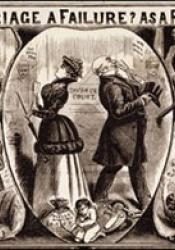The Married Women's Property Act of 1882
Before the 1880s, the legal issue regarding married women’s property rights had been an ongoing fight for about thirty years “extending back to Caroline Norton’s pamphlets on the Divorce Act and Barbara Leigh Smith Bodichon’s married women’s property petition of 1856” (Stanley, 103). The Married Women’s Property Act of 1882 is often noted as the key impact in the ongoing fight for women’s legal equality as married women as it elevated their legal status and allowed them to act as “autonomous economic agents” (Shanley, 103). This was a great improvement from the Married Women’s Property Act of 1870 in that married women gained more control over their property. However, both The Married Women’s Property Act of 1882 and the Married Women’s Property Act of 1870 still consisted of amendments that showed the government’s efforts to preserve society’s strict gender roles with the male being the superior (Shanley, 130).
The Married Women’s Property Act of 1870 although designed to move married women’s legal status forward, it was disappointing because it fell short of giving married women equal the same property rights as their husbands. The vagueness of The Married Women’s Property Act of 1870 symbolized the government’s view of this act as a threat towards the strict Victorian era gender roles. They believed that giving a woman too much financial independence would discourage her to get married (Levine, 139). To achieve an elevated legal status for married women, there would be multiple acts and reforms in parliament throughout the 1870s, 1880, 1881 and ultimately The Married Women’s Property Act of 1882 (Levine, 139). For instance, the reform of 1874 to the Married Women’s Property Act of 1870 made the husband responsible again for his wife’s debts on her property that incurred prior to their marriage, so long as the husband acquired this land when marrying his wife (Holcombe, 191).
The Married Women’s Property Act of 1882 also faced gender discrimination with Sir George Campbell and Charles Nicholas Warton claiming this would start a “social revolution” as it turned the wife into a “domestic tyrant” (Holcombe, 201). The increase in power women would have threatened the husband’s dominance as this would make the women more equal to men, disrupting the social structure (Shanley, 130). However, The Married Women’s Property Act of 1882 was soon passed, and married women had “separate interests in their property” from their husbands (Holcombe, 201). Another key amendment was that married women were now allowed to sue their husbands (V.T.H.D., 2). The Married Women’s Property Act of 1870 allowed married women to regain control of their income and certain investments and inherited property but a court hearing in 1878 proved that this right was not protected (Holcombe, 181). The judge in this case dismissed the wife’s attempt to sue her husband because he did not interpret The Married Women’s Property Act of 1870 as allowing the wife to sue her husband. Also, the married woman being able to sue and be sued, boosted her credibility among creditors. Creditors were always hesitant to loan to married women because they could not be sued and there was no guarantee they would receive their loan back (Holcombe, 183). Therefore, women were encouraged to engage in business with this new amendment as creditors faced less risk legally get their money back (Holcombe, 203).
Although The Married Woman’s Property Act of 1882 was a significant law that brought married women more legal equality, it still contained barriers for married women to achieve the same legal status as their husbands. For instance, the law prevented married women from gaining “full contractual capacity” of their “separate property” (Shanley, 127). The married woman could be relieved of her debt obligations if the property were “not her “separate property at the time she made the contract” (Shanley, 127). This section of the property act accentuated the government’s fear of challenging society’s gender roles. Granting women equal property rights, this would cause women to argue for equal political rights, in turn jeopardizing Victoria era’s role for women as inferior to men (Shanley, 129). However, the Reform Act of 1884 came about to address these restrictive amendments (Shanley, 130). Nonetheless, The Married Women’s Property Act of 1882 was a crucial victory in the revolution for married women as it improved their legal status and marital conditions within the Victorian era society (Holcombe, 204).
Works Cited
Holcombe, Lee. “Wives & Property: Reform of the Married Women’s Property Law in Nineteenth-Century England.” University of Toronto Press. 1982. https://ebookcentral.proquest.com/lib/depaullaw/reader.action?docID=5092233. Accessed 1 Oct. 2020.
‘Is Marriage a Failure?’ Cartoon. The British Library. 1891. http://www.vam.ac.uk/content/articles/p/the-personal-is-political-gender.... Accessed 1 Oct. 2020.
Levine, Philippa. Victorian Feminism 1850 – 1900. The Florida State University Press, 1987.
Shanley, Mary Lindon. Feminism, Marriage, and the Law in Victorian England. Princeton University Press, 1989.
V.T.H.D. “The Legal Status of Married Women.” Irish Jurist, vol. 21/22, no. 4, 1955-1956, pp.
49-52, http://ezproxy.depaul.edu/login?url=https://www.jstor.org/stable/44506501. Accessed 20 Sept. 2020.

